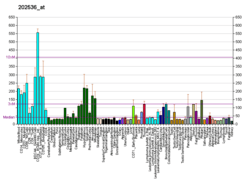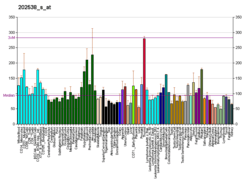CHMP2B
Charged multivesicular body protein 2b is a protein that in humans is encoded by the CHMP2B gene.[5][6] It forms part of one of the endosomal sorting complexes required for transport (ESCRT) - specifically ESCRT-III - which are a series of complexes involved in cell membrane remodelling. CHMP2B forms long chains that spiral around the neck of a budding vesicle. Along with the other components of ESCRT-III, CHMP2B constricts the neck of the vesicle just before it is cleaved away from the membrane.
Mutations of this gene cause chromosome 3-linked frontotemporal dementia (FTD3), which has been described in several members of one Danish family . In a study of French families with several forms of frontotemporal dementia, it was found to be a relatively rare cause.[7]
References
- 1 2 3 GRCh38: Ensembl release 89: ENSG00000083937 - Ensembl, May 2017
- 1 2 3 GRCm38: Ensembl release 89: ENSMUSG00000004843 - Ensembl, May 2017
- ↑ "Human PubMed Reference:".
- ↑ "Mouse PubMed Reference:".
- ↑ Howard TL, Stauffer DR, Degnin CR, Hollenberg SM (Sep 2001). "CHMP1 functions as a member of a newly defined family of vesicle trafficking proteins". J Cell Sci. 114 (Pt 13): 2395–404. PMID 11559748.
- ↑ "Entrez Gene: CHMP2B chromatin modifying protein 2B".
- ↑ Ghanim M, Guillot-Noel L, Pasquier F, Jornea L, Deramecourt V, Dubois B, Le Ber I, Brice A (July 2010). "CHMP2B mutations are rare in French families with frontotemporal lobar degeneration". J Neurol. 257 (12): 2032–6. doi:10.1007/s00415-010-5655-8. PMID 20625756.
External links
- GeneReviews/NCBI/NIH/UW entry on CHMP2B-Related Frontotemporal Dementia
- Human CHMP2B genome location and CHMP2B gene details page in the UCSC Genome Browser.
Further reading
- Maruyama K, Sugano S (1994). "Oligo-capping: a simple method to replace the cap structure of eukaryotic mRNAs with oligoribonucleotides". Gene. 138 (1–2): 171–4. doi:10.1016/0378-1119(94)90802-8. PMID 8125298.
- Brown J, Ashworth A, Gydesen S, et al. (1996). "Familial non-specific dementia maps to chromosome 3". Hum. Mol. Genet. 4 (9): 1625–8. doi:10.1093/hmg/4.9.1625. PMID 8541850.
- Suzuki Y, Yoshitomo-Nakagawa K, Maruyama K, et al. (1997). "Construction and characterization of a full length-enriched and a 5'-end-enriched cDNA library". Gene. 200 (1–2): 149–56. doi:10.1016/S0378-1119(97)00411-3. PMID 9373149.
- Ashworth A, Lloyd S, Brown J, et al. (1999). "Molecular genetic characterisation of frontotemporal dementia on chromosome 3". Dementia and Geriatric Cognitive Disorders. 10 Suppl 1: 93–101. doi:10.1159/000051222. PMID 10436350.
- Lai CH, Chou CY, Ch'ang LY, et al. (2000). "Identification of novel human genes evolutionarily conserved in Caenorhabditis elegans by comparative proteomics". Genome Res. 10 (5): 703–13. doi:10.1101/gr.10.5.703. PMC 310876. PMID 10810093.
- Wiemann S, Weil B, Wellenreuther R, et al. (2001). "Toward a catalog of human genes and proteins: sequencing and analysis of 500 novel complete protein coding human cDNAs". Genome Res. 11 (3): 422–35. doi:10.1101/gr.GR1547R. PMC 311072. PMID 11230166.
- Simpson JC, Wellenreuther R, Poustka A, et al. (2001). "Systematic subcellular localization of novel proteins identified by large-scale cDNA sequencing". EMBO Rep. 1 (3): 287–92. doi:10.1093/embo-reports/kvd058. PMC 1083732. PMID 11256614.
- Strausberg RL, Feingold EA, Grouse LH, et al. (2003). "Generation and initial analysis of more than 15,000 full-length human and mouse cDNA sequences". Proc. Natl. Acad. Sci. U.S.A. 99 (26): 16899–903. doi:10.1073/pnas.242603899. PMC 139241. PMID 12477932.
- Strack B, Calistri A, Craig S, et al. (2003). "AIP1/ALIX is a binding partner for HIV-1 p6 and EIAV p9 functioning in virus budding". Cell. 114 (6): 689–99. doi:10.1016/S0092-8674(03)00653-6. PMID 14505569.
- von Schwedler UK, Stuchell M, Müller B, et al. (2003). "The protein network of HIV budding". Cell. 114 (6): 701–13. doi:10.1016/S0092-8674(03)00714-1. PMID 14505570.
- Martin-Serrano J, Yarovoy A, Perez-Caballero D, et al. (2003). "Divergent retroviral late-budding domains recruit vacuolar protein sorting factors by using alternative adaptor proteins". Proc. Natl. Acad. Sci. U.S.A. 100 (21): 12414–9. doi:10.1073/pnas.2133846100. PMC 218772. PMID 14519844.
- Ota T, Suzuki Y, Nishikawa T, et al. (2004). "Complete sequencing and characterization of 21,243 full-length human cDNAs". Nat. Genet. 36 (1): 40–5. doi:10.1038/ng1285. PMID 14702039.
- Kelleher T, Ryan E, Barrett S, et al. (2005). "DMT1 genetic variability is not responsible for phenotype variability in hereditary hemochromatosis". Blood Cells Mol. Dis. 33 (1): 35–9. doi:10.1016/j.bcmd.2004.04.005. PMID 15223008.
- Gerhard DS, Wagner L, Feingold EA, et al. (2004). "The status, quality, and expansion of the NIH full-length cDNA project: the Mammalian Gene Collection (MGC)". Genome Res. 14 (10B): 2121–7. doi:10.1101/gr.2596504. PMC 528928. PMID 15489334.
- Takeuchi K, Bjarnason I, Laftah AH, et al. (2005). "Expression of iron absorption genes in mouse large intestine". Scand. J. Gastroenterol. 40 (2): 169–77. doi:10.1080/00365520510011489. PMID 15764147.
- Skibinski G, Parkinson NJ, Brown JM, et al. (2005). "Mutations in the endosomal ESCRTIII-complex subunit CHMP2B in frontotemporal dementia". Nat. Genet. 37 (8): 806–8. doi:10.1038/ng1609. PMID 16041373.
- Rual JF, Venkatesan K, Hao T, et al. (2005). "Towards a proteome-scale map of the human protein-protein interaction network". Nature. 437 (7062): 1173–8. doi:10.1038/nature04209. PMID 16189514.
- Cannon A, Baker M, Boeve B, et al. (2006). "CHMP2B mutations are not a common cause of frontotemporal lobar degeneration". Neurosci. Lett. 398 (1–2): 83–4. doi:10.1016/j.neulet.2005.12.056. PMID 16431024.
- Nousiainen M, Silljé HH, Sauer G, et al. (2006). "Phosphoproteome analysis of the human mitotic spindle". Proc. Natl. Acad. Sci. U.S.A. 103 (14): 5391–6. doi:10.1073/pnas.0507066103. PMC 1459365. PMID 16565220.






